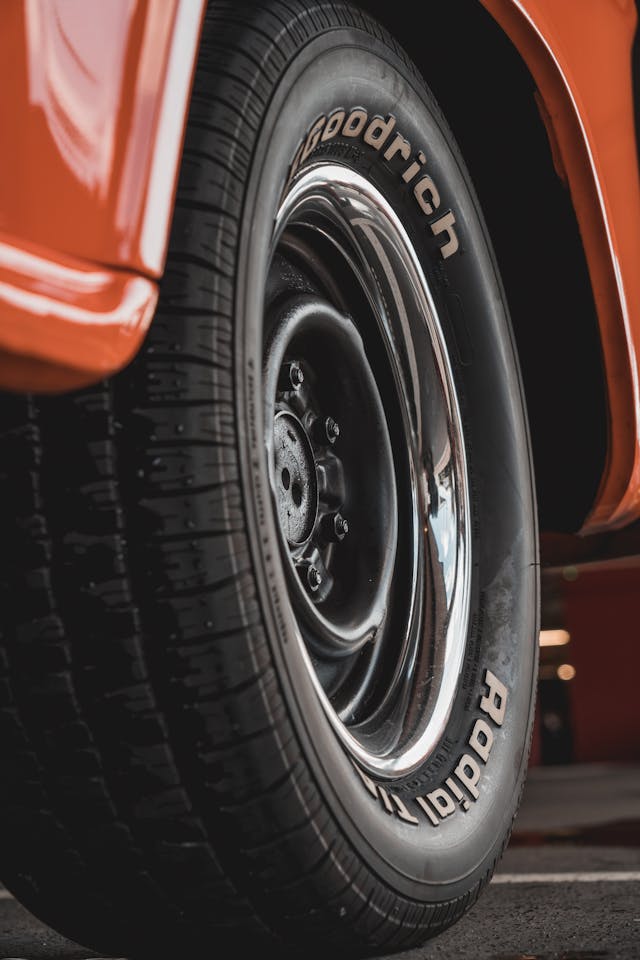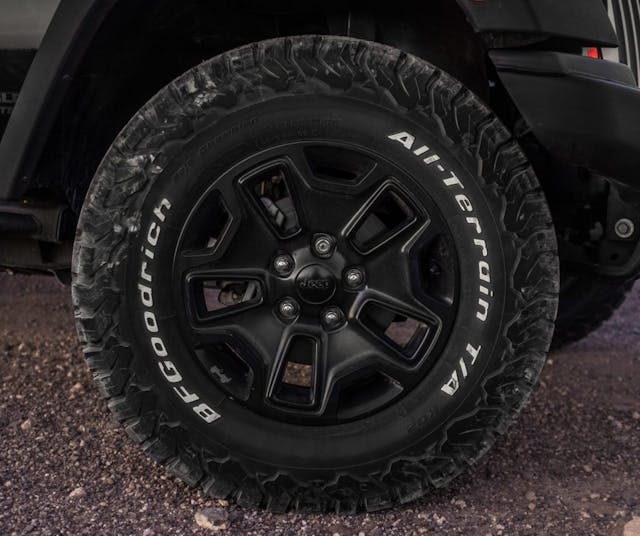Reading Your Rubber: Learn the lingo of your car’s wheels and tires

Stephen Oats writes: Can you nutshell what I need to know about wheel and tire sizes?
Let’s start with the wheels …
In order for the wheels to attach to the hubs, the bolt pattern and center bore need to be correct. Bolt pattern is the number of lug nuts and the diameter of the circle they form. On pre-1980-ish American and British cars, this was specified in inches (e.g., 5×4.5). On most modern cars, it’s stated in millimeters (e.g., 5×100). The center bore is the diameter of the hole in the middle of the wheel. Most modern cars have hub-centric wheels, where the wheel’s center bore mates with a small raised ridge on the hub. If the wheel bore is too small, it won’t fit, and if the bore is too big, the wheel may vibrate from not being centered. Hub-centric rings can be used to help them correctly seat, and machine shops can increase the bore if needed.
Width, diameter, and offset then come into play. Width is measured at the outer edges of both lips. Diameter is self-explanatory. Both are almost always expressed in inches. Offset, usually measured in millimeters, is the distance from the wheel’s mounting face (the part that sits flush against the hub) to the centerline of the wheel. Nearly all wheels have positive (inboard) offset. If the offset is too small, the wheels and tires may stick outside the fenders. Too big an offset can cause the brake calipers to rub the inside of the wheels. Backspacing is almost the same as offset, except it’s measured not to the centerline but to the inside of the wheel lip. If you’re looking to fit wheels that have a little too much offset (sit too far inboard), thin circular spacers can be used so long as they don’t interfere with the seating of the lug nuts.

Now, on to tires …
Until about 1920, cars wore skinny high-pressure tires in sizes such as 30×3, where “30” was the tire’s rolling diameter and “3” was the cross-sectional width, both in inches. To calculate the diameter of wheel they’d fit on, you needed to know that the tire’s width and height were the same; there are 3 inches at both the top and bottom, so subtracting 6 from 30, the tire would need a 24-inch wheel.
From the 1920s through the 1960s, a numeric description containing tire width and wheel diameter was used. A size such as 6.00-16 referred to a tire 6 inches wide made for a 16-inch wheel. Tires might have been available in different profiles, but it wasn’t part of the description.
The designations changed again in the late 1960s when alphanumeric descriptions came into play. A size like G70-15 meant the tire had a g-load rating (1620 pounds), a 70 percent aspect ratio (the tire’s height divided by its width, expressed as a percentage—the smaller the aspect ratio, the lower the tire’s profile), and was meant for a 15-inch wheel. Width was no longer part of the description.
Finally, in the late 1970s, P-metric tire designations were introduced. They included the three important parameters of width, aspect ratio, and wheel diameter, but, confusingly, width and diameter are specified in different units. If you see a tire size like 235/45R17, the 235 is the section width in millimeters, the 45 is the aspect ratio, and the 17 is the wheel diameter in inches.

Modern descriptions can get a bit arcane. If there’s a letter designation at the beginning, that’s the tire’s service type, and it affects load capacity. “P” means P-metric, commonly used for tires for passenger vehicles. No letter means Euro-metric, which, for the same-sized tire, usually has a slightly higher load rating than P-metric. “LT” means light truck. “ST” is special trailer service. The letter designation in the middle—the “R”—is not a speed rating, as many people think. It is a construction description. R stands for “Radial,” the design of nearly all modern tires. You might also see “D” for diagonal (bias-ply), “B” for belted, or “F” for run-flat. If the construction description is preceded by a “Z,” that is a speed rating—the tire is rated for at least 149 mph—but speed ratings have been largely absorbed by service descriptions, which contain both load indexes and speed designations. Two-digit load indexes range from 70 to 126 (739 to 3748 pounds). Speed designations are a single letter ranging from L to Y (75 to 186 mph). You never want to replace a tire with a lower speed or load rating.
You also should be aware of the DOT code. Tires manufactured since the year 2000 should be stamped with “DOT” followed by a string of letters and numbers. The last four numbers indicate the week and year of production. For example, “4317” means the tires were manufactured in the 43rd week of 2017.
If there are any cracks in the tread (or worse, sidewall bubbles), the tires aren’t safe for anything other than a slow lap around the block. If they’re only a few years old but worn down to the 2/32-inch wear bars, they won’t shed water correctly, so avoid high-speed romps in the rain until you replace them. If they’ve got lots of tread left but are getting old, it’s a tough decision. Generally, tires have a life span of 6–10 years. Be pragmatic: If you use your car for high-performance driving, you can’t afford to be wrong about tire safety. If its main use is low-speed drives to cars and coffee, the bar is lower.
Before you buy, speak with a specialist or look for websites that calculate tire sizes to approximate those you’re replacing. All that’s left then is to put the rubber to the road and go.

How to read the sidewall codes on your tires
Today’s tires all include the same types of information, much of it coded, so check reputable tire websites for the keys. (1) Tire type and sizing tells you what kind of vehicle it is for (P = passenger car), section width (not tread width) in millimeters, aspect ratio, the tire’s construction type, and wheel diameter in inches. (2) The load and speed indexes reflect how much weight a tire can safely carry (99 = 1709 pounds), and how fast it is rated to go (H = 130 mph). (3) Treadwear, (4) Traction, and (5) Temperature ratings are based on each manufacturer’s specs and indicate: relative durability—how many miles you can expect, in this case, roughly 22,000; how well the tire stops in a straight line on a wet surface; and how well a tire stands up to heat under normal operation. (6) Max pressure is self-explanatory but too often ignored. Inflate your tires properly! (7) The last four digits here show what week and year your tires were manufactured.


Hello,
I’ve been a long time Hagerty / Drivers Club member with my British cars, 1962 MGA 1600 mk2, 1974 MG Midget and 1961 Austin Healey Sprite. I’m also the President of the Minesota MG Group. The club has grown significantly in the last 3 years to 280 members. I attribute it to the affordability, easy to maintain, accessible parts and the fact that may cars are becoming available as the original owners have aged out of the Hobby. At a recent club meeting the conversation about when to put new tires on their cars came up. I would like your permission to share the article “Rubber: Learn the lingo of your car’s wheels and tires ” in our monthly club newsletter technical section.
Please let me know if I have your permission to use this article. I will give the source of the article and original author. Thank you for your consideration. Paul Lyon 2589 ns Way North Saint Paul Minnesota 55109 – plyon1962@gmail.com